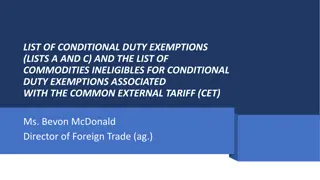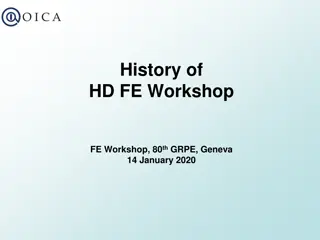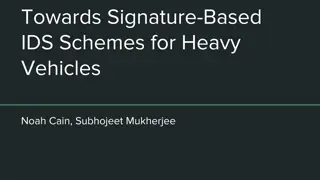Energy Consumption Test Methods for Heavy-Duty Commercial Vehicles in China
China has released energy consumption testing methods for various types of fuel vehicles, including traditional fuel vehicles, hybrid electric vehicles, battery electric vehicles, fuel cell vehicles, natural gas vehicles, and methanol vehicles. The standards cover test methods for fuel consumption and range of heavy-duty commercial vehicles, with specific requirements and procedures outlined for different vehicle types. Testing includes gear shift tests, determination of road load, and speed requirements to ensure accurate measurement of energy consumption.
Download Presentation

Please find below an Image/Link to download the presentation.
The content on the website is provided AS IS for your information and personal use only. It may not be sold, licensed, or shared on other websites without obtaining consent from the author. Download presentation by click this link. If you encounter any issues during the download, it is possible that the publisher has removed the file from their server.
E N D
Presentation Transcript
Energy consumption test methods for heavy-duty commercial vehicles in China CATARC, 23.May 2024
Related standards China has released energy consumption testing methods covering various types of fuel vehicles, including traditional fuel vehicles, hybrid electric vehicles, battery electric vehicles, fuel cell vehicles, natural gas vehicles and methanol vehicles. Traditional fuel vehicles Fuel cell vehicles 1 4 GB/T 27840-2021 Fuel consumption test methods for heavy-duty commercial vehicles (First version issued in 2008) GB/T 43252-2023 Test methods for energy consumption and range of fuel cell electric vehicles (First version) Hybrid electric vehicles Natural gas vehicles 2 5 GB/T 19754-2021 Test methods for energy consumption of heavy-duty hybrid electric vehicles (First version issued in 2005) GB/T 29125-2012 Test methods for fuel consumption of CNG vehicles (First version) Battery electric vehicles Methanol vehicles 3 6 GB/T 18386.2-2022 Test methods for energy consumption and range of electric vehicles - Part 2: Heavy-duty commercial vehicles (First version issued in 2005) QC/T 1130-2021 Measurement methods for fuel consumption of methanol vehicles (First version) 2
1. Traditional fuel vehicles GB/T 27840 applies to vehicles fueled with gasoline or diesel with a technically permissible maximum laden mass exceeding 3,500 kg, including trucks, tractor-trailers, coaches, dumpers, and city buses The tests should be conducted according to China Automotive Test Cycles, and vary for different vehicle types. City buses Coaches Trucks (GVW 5500kg Trucks (GVW>5500kg Dumpers Tractor-trailers 3
1. Traditional fuel vehicles Test requirements and procedure Gear shift Test methods 01 05 Vehicles with energy-saving driving instructions can shift gears Basic vehicles should use chassis dynamometer method; according to the corresponding instructions. Variant vehicles should have the option to use chassis dynamometer method or simulation method Test procedure Road load 02 06 The vehicle test should run 3 complete test cycles Coastdown method, torque meter method, lookup table method Speed requirements Atmospheric temperature 03 07 The speed deviation is 3km/h. The single time exceeding the The recommended atmospheric temperature is 23 5 speed deviation should not exceed 2s, and the cumulative time should not exceed 15s Special treatment Preconditioning 08 04 It is advisable to conduct 1-2 complete test cycles or use When the test vehicle cannot reach the acceleration or test other methods to fully preheat the test vehicle and chassis speed required by the test cycles, the accelerator pedal should dynamometer be fully pressed to the bottom, and this operation is not counted as a single or cumulative time exceeding the speed deviation 4
1. Traditional fuel vehicles The road load The determination of the road load of a test vehicle and the transfer of that road load to a chassis dynamometer: Coastdown method Torque meter method Lookup table method For vehicles with other gross vehicle weight, the interpolation method should be used. 5
1. Traditional fuel vehicles Test results Use one of the following three method 01 It should be noted that, the National VI emission standard released in 2018 added vehicle emission testing. simultaneous test of fuel consumption and emissions, currently, the carbon balance method is commonly used Carbon balance method To achieve 02 Weighing method 03 Volumetric method 6
2. Hybrid electric vehicles The test cycles, road load setting, etc. are consistent with traditional fuel vehicles. For vehicles with a maximum speed lower than the base test cycle, the base cycle shall be modified in order to achieve the same cycle distance for the capped speed cycle as for the base cycle. Example: City buses 50 50 CHTC-B-modification CHTC-B 40 40 modification Speed(km/h) Speed(km/h) 30 30 20 20 10 10 0 0 0 200 400 600 800 1000 1200 1400 0 200 400 600 800 1000 1200 1400 Time(s) Time(s) 7
2. Hybrid electric vehicles Test procedure and test results for NOVC-HEV The test should be conducted at least 3 times. For the vehicles that can achieve charge sustaining, the test results only include fuel consumption, which is obtained through linear regression Fuel consumption (L/100km) For the vehicles that cannot achieve charge sustaining, a maximum number of test cycles has been set, and the test results shall include fuel consumption and energy consumption. 8
2. Hybrid electric vehicles Test results for NOVC-HEV Calculate the experimental results based on the energy changes of REESS NEC E tr 100% NEC re cycle *Ecycleis cycle energy demand, same with UN R154 IF |NECre| 1%, take the average of three test results as the fuel consumption; and GTR 15 IF 1%<|NECre| 5%, using linear regression to calculate fuel consumption; = NEC k Pdt For the battery: = P k U I 1 I IF |NECre|>5%, additional tests are required. = d I I c c d ( ) = 2 2 2 NEC k C U U For the supercapacitor: 2 c b 9
2. Hybrid electric vehicles Test procedure for OVC-HEV Before the test, the vehicle shall be fully charged, and then the three-phase test shall be carried out. Each of the three-phase test involves multiple test cycles. From the beginning to the engine start, the pure electric phase (phase I*) test ends; then, when the energy balance occurs for the first time, the rechargeable electrical (REESS) energy adjustment phase (phase II) test ends; finally, when there are two more energy balance tests occur, the charge sustaining phase (phase III) test ends. energy storage system After the test, the vehicle shall be fully charged again and the charging electricity shall be measured. Some special vehicle types don t include pure electric operation mode or phase III. In this case, special treatment is required. *It should be note that, during phase I test, the engine start caused by air injection is not considered as the end of the test. The OEMs need to provide corresponding materials to prove that the engine did not participate in the vehicle driving and did not charge the REESS during the air injection process 10
2. Hybrid electric vehicles Test results for OVC-HEV Fuel consumption Energy consumption 1. Phase I (including fuel consumption generated by inflation) 1. Phase I n n 1 ( ) ( ) 1 + ' + UF FC UF FC ' UF EC UF EC + 1 c c n n + E AC, 1 AC, c c n n 1 1 1 1 = = AC 1 = c = EC EC = FC 1 c EC AC, DC, c c s1 AC,s1 n 1000 NEC n 1 1 + ' tot + ' UF UF UF UF + 1 c n + 1 c n 1 1 = 1 = c 1 c n 2. Phase II 2. Phase II 2 ( ) n UF FC ( ) 2 UF EC c c AC, c c c n = + 2 = FC 1 c n = + 2 = EC s2 1 n 2 AC,s2 n UF 2 UF c c c n = + 2 1 c n = + 2 1 3. Phase III 3. Phase III, equal to 0 FC s3 4. Fuel consumption of OVC-HEV 4. Energy consumption of OVC-HEV n n 1 2 n n n n = + + ' 1 2 1 2 EC EC UF UF EC UF = + + + + ' ' 1 FC FC UF UF FC UF FC UF UF UF + AC,s1 1 AC,s2 c n c + + 1 s1 1 s2 s3 1 c n c c n c 1 1 = c n = + 1 2 c = c n = + = c n = + 1 2 1 2 c c 1 1 1 Range + NEC NEC = m s1 1000 S EC DC,s1 11
2. Hybrid electric vehicles Utilization factor (UF) Utilization factor (UF) is fitted according to the actual one-day travel characteristics in China. It is gradually tends to 1 with the increase of driving range, giving different weight coefficients per cycle. Based on UF, the comprehensive energy consumption of PHEV can be obtained. x c d l 10 1 c ( ) 1 exp = = 1 l UF d C UF c c x l d = = 1 1 x l n 1.0 0.9 0.8 City bus Bus Coach with GVW>5500kg Tractor-trailer Dumper Coach with GVW 5500kg 0.7 0.6 UF 0.5 0.4 0.3 0.2 0.1 0.0 0 100 200 300 400 500 600 700 800 Range(km) 12
3. Battery electric vehicles The test cycles, road load setting, test cycles, etc. are consistent with HEV. The GB/T standard specifies two methods: consecutive cycle test procedure and shortened test procedure Consecutive cycle test procedure Shortened test procedure DS1and DS2each contain 2 test cycles 13
3. Battery electric vehicles The calculation method for range varies under different methods, but for energy consumption is the same Range Shortened test procedure Consecutive cycle test procedure E E E ( ) ( ) REESS,DS REESS, c 2 , 2 c c c E E 4 E n ( ) ( ) REESS,STP EC = = REESS,CCP EC = = = BER EC EC K K = REESS,CCP K n BER EC EC K K REESS,STP K DC DC, c c c DC DC, c c c 1 1 K K = = 1 c ( ) ( ) 1 c DC DC 1 2 1 2 2 2 c , 2 c 2 1. The first two test cycles only represent that cycle, while the last 1. Distinguish the energy consumption between the first two test two test cycles represent the energy consumption of all cycles cycles and the subsequent test cycles; after the first two test cycles with the same weight. 2. N is the complete number of test cycles, excluding the last incomplete test cycle. Energy consumption Calculate energy consumption based on driving range and external charging REESS,CCP STP E E BER ( ) = AC EC + REESS,CCP STP E E ( ) REESS,af 14












































